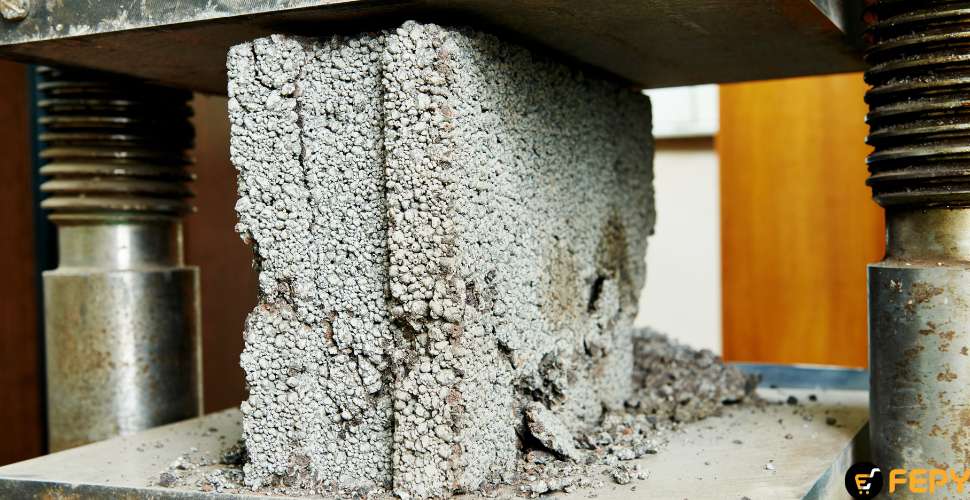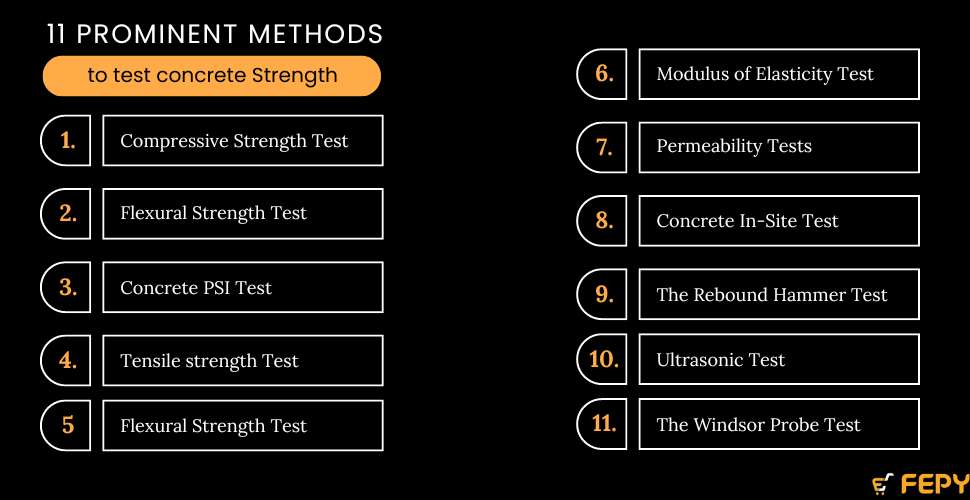How to Test Concrete Strength for UAE Building Projects

March 15th 2024
Concrete is the foundation of construction. It is renowned for its Strength and durability. But did you know that this Strength isn't one-size-fits-all? Different types of Strength contribute to concrete's versatility, making it suitable for various applications.
In the UAE, you can access multiple methods for measuring concrete Strength. However, each method has its purpose and limitations. Choosing the right one for your project is crucial.
How to Test Concrete Strength?
There are 11 prominent methods to test concrete Strength:
- Compressive Strength Test
- Flexural Strength Test
- Concrete PSI Test
- Tensile strength Test
- Flexural Strength Test
- Modulus of Elasticity Test
- Permeability Tests
- Concrete In-Site Test
- The Rebound Hammer Test
- Ultrasonic Test
- The Windsor Probe Test

Now, discuss these test methods in detail.
1. Compressive Strength Test
The compressive strength test is the most widespread and trusted method for assessing concrete Strength. It gauges the material's ability to resist forces that squeeze or compress it.
Concrete shines under compression, effortlessly handling significant loads. However, its tensile Strength, or ability to resist pulling forces, is about ten times weaker.
The primary method for measuring compressive Strength involves applying a crushing force to a cylindrical concrete sample until it breaks. This test reveals the maximum load the concrete can withstand.
Engineers rely heavily on compressive strength measurements to set specifications for projects carrying vertical loads. They determine the required load, add a safety factor, and specify the concrete Strength needed for safe construction, ensuring the structure can handle its intended use.
Compressive Strength is the primary factor in determining whether a specific concrete mix meets your project's requirements.
2. Flexural Strength Test:
When dealing with structures like roads, airport runways, or taxiways, where loads roll or bend the concrete (causing flexural forces), the focus shifts to flexural Strength.
Unlike compressive Strength, flexural Strength, also known as the modulus of rupture, is measured by subjecting the concrete to bending forces. It exposes the concrete to compression and tension zones, focusing on the latter.
Since concrete has a lower tensile strength, this test primarily assesses the material's resistance to pulling forces, providing valuable data for engineers.
Material testing professionals can provide engineers with critical data on load-bearing capacity and safety for crucial projects like roads and airports by measuring the load and calculating the modulus of rupture.
3. Concrete PSI Test:
PSI (pounds per square inch) is the universal language for concrete's compressive Strength. A higher PSI signifies a sturdier concrete mix, often translating to a higher price tag. However, these stronger concretes boast superior durability, meaning they stand the test of time more effectively.
The ideal PSI for your project hinges on various factors. Generally, the minimum acceptable PSI starts around 2,500 to 3,000 PSI for any project. Different concrete structures have their own recommended PSI ranges.
For example, concrete footings and slabs resting directly on the ground typically require a PSI of 3,500 to 4,000. In contrast, suspended slabs, beams, and girders (like those in bridges) need a higher range of 3,500 to 5,000 PSI.
Traditional concrete walls and columns usually fall within the 3,000 to 5,000 PSI range, whereas pavements demand a slightly higher 4,000 to 5,000 PSI.
Concrete structures in colder climates require a higher PSI to withstand harsh freeze-thaw cycles.
4. Tensile Strength Test:
While compressive Strength excels at resisting squeezing forces, tensile Strength is all about concrete's ability to combat cracking and breaking under pulling forces.
It directly impacts the size and frequency of cracks that might appear in concrete structures. Cracks form when tensile forces surpass the concrete's tensile Strength.
Traditional concrete exhibits a significantly lower tensile strength compared to its compressive Strength. It implies that concrete structures experiencing tensile stress need reinforcement with materials boasting high tensile Strength, such as steel.
Directly testing concrete's tensile strength is challenging. Therefore, you can resort to indirect methods like flexural Strength and split tensile Strength.
5. Flexural Strength Test:
The Flexural Strength Test is another method to measure tensile Strength. It gauges an unreinforced concrete slab or beam's ability to resist bending and prevent failure. In simpler terms, it reflects the concrete's resistance to bending forces.
Flexural Strength typically falls within 10 to 15 percent of the compressive Strength, depending on the specific concrete mix.
Two standard tests exist to determine the flexural strength of concrete, with results expressed in PSI as the Modulus of Rupture (MR).
It's important to note that flexural tests are susceptible to factors like concrete preparation, handling, and curing.
Researchers typically perform these tests on wet specimens. For these reasons, compressive strength test results are generally considered more reliable for representing concrete Strength.
6. Modulus of Elasticity Test:
The modulus of elasticity test delves deeper than basic strength measurements. It assesses the stiffness of concrete by calculating the ratio of stress (applied force) to strain (deformation) under various loads.
Think of it as a measure of how much a concrete element bends under pressure. The stiffer the material, the higher its modulus of elasticity.
This information is crucial for engineers as it helps them make informed decisions during the building process and inspections.
7. Permeability Tests:
Imagine concrete like a fortress, guarding your structure from external threats. However, if it's too porous (permeable), it can become vulnerable to invaders like moisture, oxygen, and even CO2, leading to corrosion.
Permeability tests help ensure your concrete uses the correct formulation to maintain its durability and resilience.
8. Concrete In-Site Test:
Many professionals like to test concrete Strength directly on the construction site for convenience. Various in-site tests are available, some involving destruction and others offering a non-destructive approach.
Some professional commonly used methods include pull-out tests, break-off tests, and the Schmidt Hammer test.
These tests often rely on field-cured cylinders and similar equipment to estimate concrete Strength over time.
9. The Rebound Hammer Test:
The rebound hammer test is a popular choice for its simplicity and field-friendliness. Since the mid-20th century, engineers and builders have widely used it to evaluate the compressive strength of concrete structures and determine their load-bearing capacity and durability.
FEPY's rebound hammers are known for accurately measuring concrete's compressive Strength.
10. Ultrasonic Test
Ultrasonic testing is a powerful tool for monitoring concrete's Strength and deterioration caused by age, fire, frost, or chemical attack.
This non-destructive method also boasts additional capabilities. It can measure concrete thickness, locate hidden defects like voids and honeycombing, and even detect objects like pipes and ducts embedded within the concrete.
11. The Windsor Probe Test
The Windsor Probe test utilizes a hardened steel probe with a conical tip. This probe is fired into the concrete surface using a gun and cartridge. The depth of penetration determines the concrete's Strength.
A non-explosive alternative exists in the Windsor Pin, which uses a spring-loaded mechanism to drive a steel pin into the concrete or mortar.
Key Factors Related to Concrete Strength
You've explored the different concrete testing methods. Now, let's delve into the key factors influencing concrete's Strength:
I. The Water-to-Cement Ratio (w/cm)
Imagine concrete as a delicious recipe. The water-to-cement ratio (w/cm) is like the salt: essential, but too much can spoil the dish. A lower w/cm ratio results in stronger concrete. Still, it also makes it less workable, requiring more effort to pour and smooth. Striking the right balance is crucial to achieve both Strength and workability.
II. The Perfect Proportion
Think of concrete as a well-balanced unit. Just like a unit needs the right combination of professionals, concrete requires the correct proportion of ingredients for optimal Strength. These ingredients include water, cement, air, and an aggregate mix of sand, gravel, and stone.
Too much cement paste might make the concrete easy to pour initially, but it becomes brittle and cracks easily in the long run. Conversely, skimping on cement paste leads to rough, porous concrete that needs more durability.
III. The Efficient Mixing
Mixing time plays a crucial role in concrete's Strength. While Strength generally increases with mixing up to a certain point, overdoing it can backfire.
Excessive mixing leads to water evaporation and the formation of fine particles, making the concrete challenging to work with and ultimately weaker.
Unfortunately, there's no one-size-fits-all answer for ideal mixing time. It depends on various factors like the type of mixer, its rotation speed, and the specific components of the concrete batch.
IV. Curing for long-lasting Strength
Imagine concrete curing like a plant growing. The longer you keep it moist, the stronger it becomes. Therefore, proper curing methods are essential, especially in extreme hot or cold weather, to protect the concrete and ensure it reaches its full potential Strength.
Frequently Asked Questions (FAQs)
What is the primary test for fresh concrete?
Fresh concrete undergoes various tests, including the slump test to measure workability and consistency, air content measurement to determine trapped air, and temperature monitoring to ensure the concrete falls within the desired temperature range.
What is PSI in concrete?
PSI (pounds per square inch) measures compressive Strength, which reflects concrete's ability to handle loads or compression. A higher PSI indicates stronger concrete.
What is the grade of concrete?
Remember that concrete grade refers to its strength measured after 28 days of curing. The structural needs and the specific concrete mix used determine the strength. Typically, people use nominal mixes for minor projects, whereas they employ design mixes for more extensive constructions.
Final Words
Quality control in concrete structures relies heavily on various tests. Each test provides valuable insights into specific aspects of substantial quality. Choosing the most appropriate tests depends on your particular project requirements and needs.
Ready to Explore the Best Concrete Products for Your Project? Visit FEPY’s extensive eCommerce store to browse a wide variety of high-quality concrete products, construction materials, and tools from trusted suppliers in the UAE.
With the knowledge you've gained about concrete Strength and testing, you're better prepared to make informed choices for your construction needs.